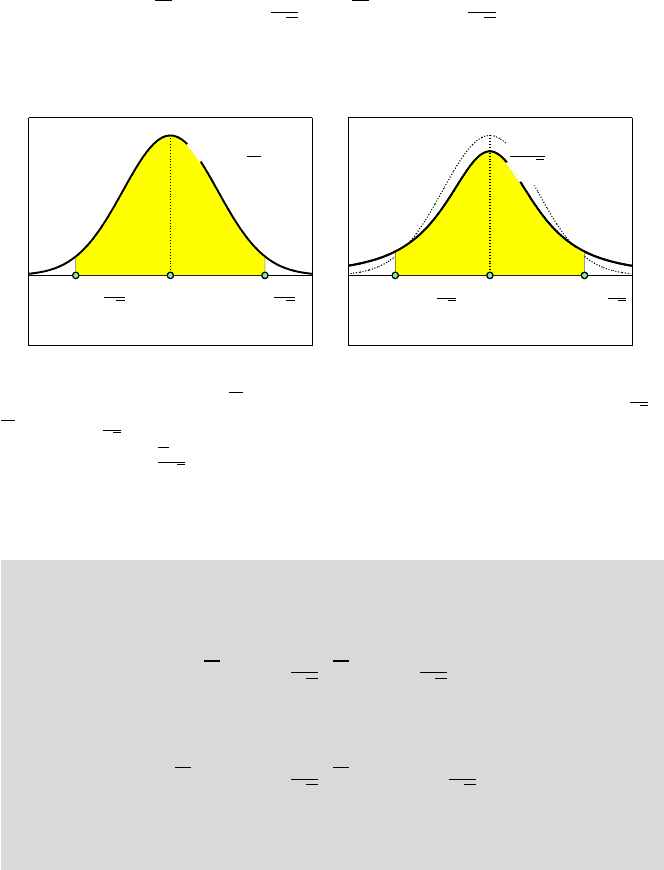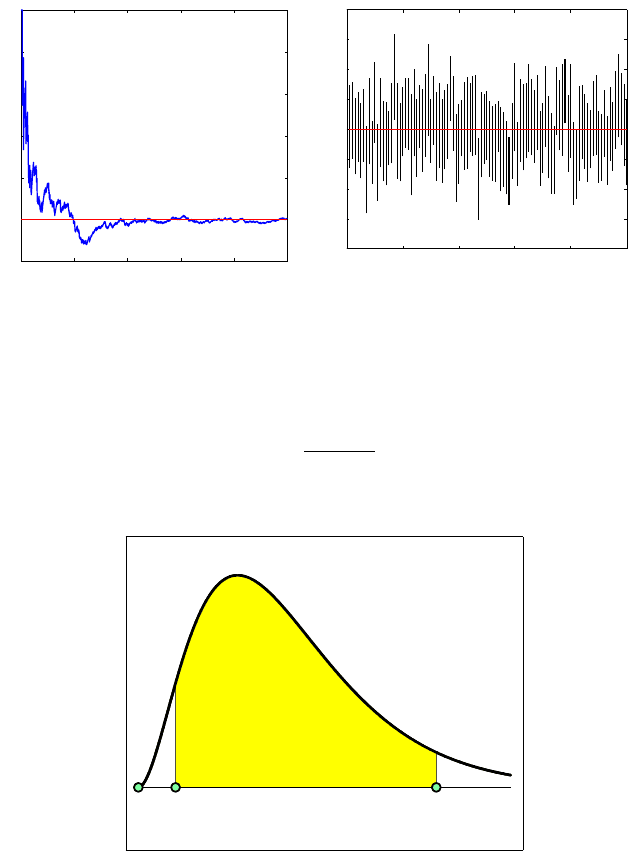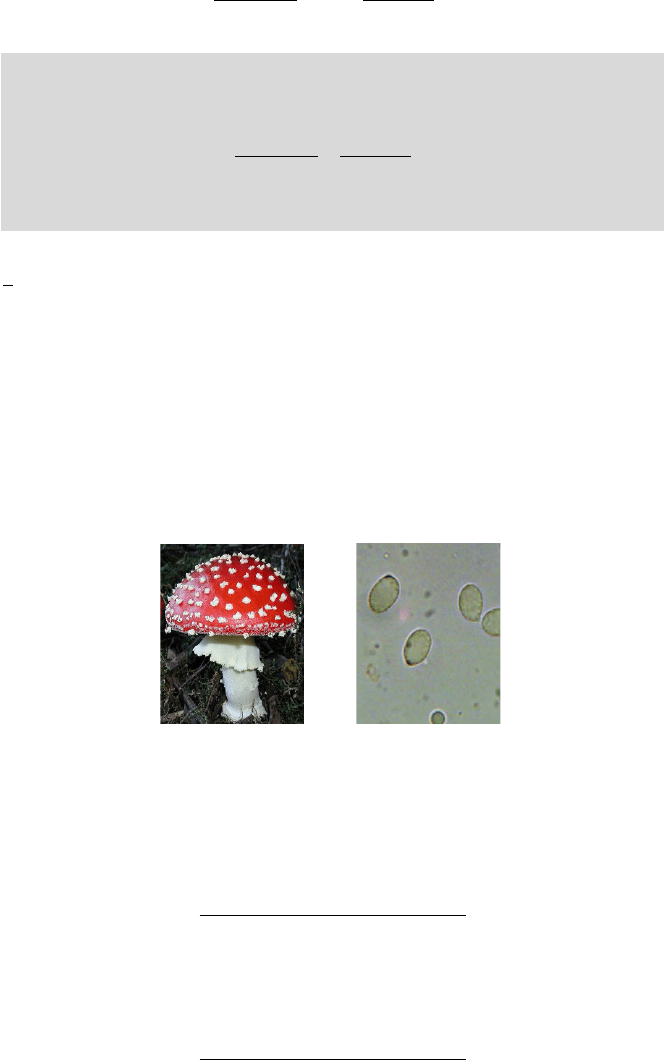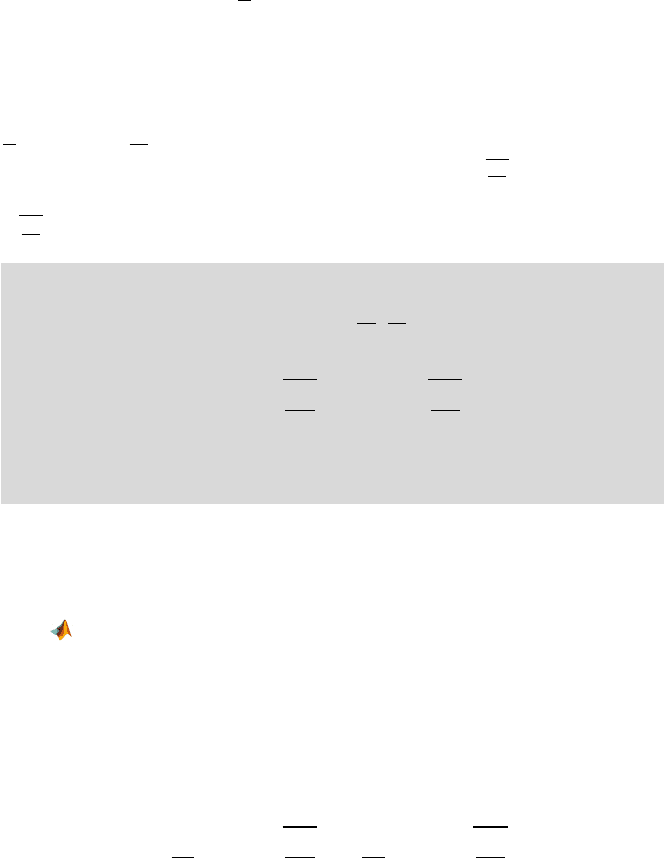Vidakovic B. Statistics for Bioengineering Sciences: With Matlab and WinBugs Support
Подождите немного. Документ загружается.


7.4 Confidence Intervals 247
are standard normal and Student t
n−1
, respectively.
The expression for t is shown as a product to emphasize the construction of a
t-distribution from a standard normal (in blue) and
χ
2
(in red), as in p. 208).
When the population is not normal but n is large, both statistics Z and t
have an approximate standard normal distribution due to the CLT.
Wa saw that the point estimator for the population proportion (of “suc-
cesses”) is the sample proportion
ˆ
p
= X /n, where X is the number of successes
in n trials. The statistic X /n is based on a binomial sampling scheme in which
X has exactly a binomial
B in(n, p) distribution. Using this exact distribution
would lead to confidence intervals in which the bounds and confidence levels
were discretized. The normal approximation to the binomial (CLT in the form
of de Moivre’s approximation) leads to
ˆ
p
approx
∼ N
µ
p,
p(1
− p)
n
¶
, (7.4)
and the confidence intervals for the population proportion p would be based
on normal quantiles.
7.4.1 Confidence Intervals for the Normal Mean
Let X
1
,... , X
n
be a sample from a N (µ,σ
2
) distribution where the parameter
µ is to be estimated and σ
2
is known.
Starting from the identity
P(−z
1−α/2
≤ Z ≤ z
1−α/2
) =1 −α
and the fact that X has a N (µ,
σ
2
n
) distribution, we can write
P
µ
−z
1−α/2
σ
p
n
+µ ≤ X ≤ z
1−α/2
σ
p
n
+µ
¶
=
1 −α;
see Fig. 7.4a for an illustration. Simple algebra gives
X −z
1−α/2
σ
p
n
≤µ ≤ X +z
1−α/2
σ
p
n
, (7.5)
which is a (1
−α)100% confidence interval.
If
σ
2
is not known, then a confidence interval with the sample standard
deviation s in place of
σ can be used. The z quantiles are valid for large n, but
for small n (n
<40) we use t
n−1
quantiles, since the sampling distribution for
X −µ
s/
p
n
is t
n−1
. Thus, for σ
2
unknown,

248 7 Point and Interval Estimators
X −t
n−1,1−α/2
s
p
n
≤µ ≤ X +t
n−1,1−α/2
s
p
n
(7.6)
is the confidence interval for
µ of level 1 −α.
µ
µ − z
1−α/2
σ
√
n
µ + z
1−α/2
σ
√
n
¯
X ∼ N
µ
µ,
σ
2
n
¶
1 −α
µ
µ − t
n−1,1−α/2
s
√
n
µ + t
n−1,1−α/2
s
√
n
¯
X −µ
s/
√
n
∼ t
n−1
1 −α
(a) (b)
Fig. 7.4 (a) When
σ
2
is known, X has a normal N (µ,σ
2
/n) distribution and P (µ−z
1−α/2
σ
p
n
≤
X ≤ µ + z
1−α/2
σ
p
n
) = 1 −α, leading to confidence interval (7.5). (b) If σ
2
is not known and s
2
is used instead, then
X −µ
s/
p
n
is t
n−1
, leading to the confidence interval in (7.6).
Below is a summary of the above-stated intervals.
The (1 −α) 100% confidence interval for an unknown normal mean µ on
the basis of a sample of size n is
·
X −z
1−α/2
σ
p
n
,
X +z
1−α/2
σ
p
n
¸
when the variance σ
2
is known and
·
X −t
n−1,1−α/2
s
p
n
,
X +t
n−1,1−α/2
s
p
n
¸
when the variance σ
2
is not known and s
2
is used instead.
Interpretation of Confidence Intervals. What does a “confidence of
95%” mean? A common misconception is that it means that the unknown mean
falls in the calculated interval with a probability of 0.95. Such a probability
statement is valid for credible sets in the Bayesian context, which will be dis-
cussed in Chap. 8.
The interpretation of the (1
−α) 100% confidence interval is as follows.
If a random sample from a normal population is selected a large number of

7.4 Confidence Intervals 249
times and the confidence interval for the population mean µ is calculated, the
proportion of such intervals covering
µ approaches 1 −α.
The following MATLAB code illustrates this. The code samples M
=10000
times a random sample of size n
= 40 from a normal population with a mean
of
µ = 10 and a variance of σ
2
= 4
2
and calculates a 95% confidence interval.
It then counts how many of the intervals cover the mean
µ, cover = 1, and, fi-
nally, finds their proportion,
covers/M. The code was run consecutively several
times and the following empirical confidences were obtained: 0.9461, 0.9484,
0.9469, 0.9487, 0.9502, 0.9482, 0.9502, 0.9482, 0.9530, 0.9517, 0.9503, 0.9514,
0.9496, 0.9515, etc., clearly scattering around 0.95. Figure 7.5a plots the be-
havior of the coverage proportion when simulations range from 1 to 10,000.
Figure 7.5b plots the first 100 intervals in the simulation and their position
with respect to
µ = 10. The confidence intervals in simulations 17, 37, 47, 58,
78, and 82 fail to cover
µ.
M=10000; %simulate M times
n = 40; % sample size
alpha = 0.05; %1-alpha = confidence
tquantile = tinv(1-alpha/2, n-1);
covers =[];
for i = 1:M
X = 10 + 4
*
randn(1,n); %sample, mean=10, var =16
xbar = mean(X); s = std(X);
LB = xbar - tquantile
*
s/sqrt(n);
UB = xbar + tquantile
*
s/sqrt(n);
% cover=1 if the interval covers population mean 10
if UB < 10 | LB > 10
cover = 0;
else
cover = 1;
end
covers =[covers cover]; %saves cover history
end
sum(covers)/M %proportion of intervals covering the mean
7.4.2 Confidence Interval for the Normal Variance
Earlier (p. 209) we argued that the sampling distribution of
(n−1)s
2
σ
2
was χ
2
with n −1 degrees of freedom. From the definition of χ
2
n
−1
quantiles,
1
−α =P(χ
2
n
−1,α/2
≤χ
2
n
−1
≤χ
2
n
−1,1−α/2
),
as in Fig. 7.6. Replacing
χ
2
n
−1
with
(n−1)s
2
σ
2
, we get

250 7 Point and Interval Estimators
0 2000 4000 6000 8000 10000
0.94
0.95
0.96
0.97
0.98
0.99
1
0 20 40 60 80 100
6
7
8
9
10
11
12
13
14
Simulation number
(a) (b)
Fig. 7.5 (a) Proportion of intervals covering the mean plotted against the iteration number,
as in
plot(cumsum(covers)./(1:length(covers)) ). (b) First 100 simulated intervals.
The intervals 17, 37, 47, 58, 78, and 82 fail to cover the true mean.
1 −α =P
µ
χ
2
n
−1,α/2
≤
(n −1)s
2
σ
2
≤χ
2
n
−1,1−α/2
¶
.
0
χ
2
n−1,α/2
χ
2
n−1,1−α/2
1 − α
α/2 α/2
Fig. 7.6 Confidence interval for normal variance σ
2
is derived from P(χ
2
n
−1,α/2
≤ (n −
1)s
2
/σ
2
≤χ
2
n
−1,1−α/2
) =1 −α.
Simple algebra with the above inequalities (taking the reciprocal of all
three parts, being careful about the direction of the inequalities, and multi-
plying everything by (n
−1)s
2
) gives

7.4 Confidence Intervals 251
(n −1)s
2
χ
2
n
−1,1−α/2
≤σ
2
≤
(n −1)s
2
χ
2
n
−1,α/2
.
The (1 −α) 100% confidence interval for an unknown normal variance is
"
(n −1)s
2
χ
2
n
−1,1−α/2
,
(n
−1)s
2
χ
2
n
−1,α/2
#
. (7.7)
Remark. If the population mean
µ is known, then s
2
is calculated as
1
n
P
n
i
=1
(X
i
−µ)
2
, and the χ
2
quantiles gain one degree of freedom (n instead
of n
−1). This makes the confidence interval a bit tighter.
Example 7.8. Amanita muscaria. With its bright red, sometimes dinner-
plate-sized caps, the fly agaric (Amanita muscaria) is one of the most striking
of all mushrooms (Fig. 7.7a). The white warts that adorn the cap, the white
gills, a well-developed ring, and the distinctive volva of concentric rings dis-
tinguish the fly agaric from all other red mushrooms. The spores of the mush-
room print white, are elliptical, and have a (maximal) diameter in the range
of 7 to 13
µm (Fig. 7.7b).
(a) (b)
Fig. 7.7 Amanita muscaria and its spores. (a) Fly agaric or Amanita muscaria. (b) Spores
of Amanita muscaria.
Measurements of the diameter X of spores for n =51 mushrooms are given
in the following table:
10 11 12 9 10 11 13 12 10 11
11 13 9 10 9 10 8 12 10 11
9 10 7 11 8 9 11 11 10 12
10 8 7 11 12 10 9 10 11 10
8 10 10 8 9 10 13 9 12 9
9

252 7 Point and Interval Estimators
Assume that the measurements are normally distributed with mean µ and
variance
σ
2
, but both parameters are unknown. The sample mean and vari-
ances are
X = 10.098 , s
2
= 2.1702, and s =1.4732. Also, the confidence inter-
val would use an appropriate t-quantile, in this case
tinv(1-0.05/2, 51-1) =
2.0086
.
The 95% confidence interval for the population mean,
µ, is
·
10.098 −2.0086 ×
1.4732
p
51
, 10.098
+2.0086 ×
1.4732
p
51
¸
=
[9.6836,10.5124].
Thus, the unknown mean
µ belongs to the interval [9.6836,10.5124] with con-
fidence 95%. That means that if the sample is obtained many times and for
each sample the confidence interval is calculated, 95% of the intervals would
contain
µ.
To find, say, the 90% confidence interval for the population variance,
σ
2
, we
need
χ
2
quantiles, chi2inv(1-0.10/2, 51-1) = 67.5048, and chi2inv(0.10/2,
51-1) = 34.7643
. According to (7.7), the interval is
[
(51
−1) ×2.1702/67.5048, (51 −1) ×2.1702/34.7643
]
=[1.6074,3.1213].
Thus, the interval [1.6074,3.1213] covers the population variance
σ
2
with a
confidence of 90%.
Example 7.9. An alternative confidence interval for the normal variance is
possible. Since by the CLT s
2
approx
∼ N
³
σ
2
,
2σ
4
n−1
´
(Can you explain why?),
when n is not small, an approximate (1
−α)100% confidence interval for σ
2
is
"
s
2
−z
1−α/2
·
p
2 s
2
p
n −1
, s
2
+z
1−α/2
·
p
2 s
2
p
n −1
#
.
In Example 7.8, s
2
= 2.1702 and n = 51. A 90% confidence interval for the
variance was [1.6074,3.1213]. By normal approximation,
s2 = 2.1702; n=51; alpha = 0.1;
[s2 - norminv(1-alpha/2)
*
sqrt(2)
*
s2/sqrt(n-1), ...
s2 + norminv(1-alpha/2)
*
sqrt(2)
*
s2/sqrt(n-1)]
%ans = 1.4563 2.8841
The interval [1.4563, 2.8841] is shorter, compared to the standard con-
fidence interval [1.6074,3.1213] obtained using
χ
2
quantiles, as 1.4278 <
1.5139. Insisting on equal-probability tails does not lead to the shortest in-
terval since the
χ
2
distribution is asymmetric. In addition, the approximate
interval is centered at s
2
. Why, then, is this interval not used? The coverage
probability of a CLT-based interval is smaller than the nominal 1
−α, and un-
less n is large (
>100, say), this discrepancy can be significant (Exercise 7.26).

7.4 Confidence Intervals 253
7.4.3 Confidence Intervals for the Population Proportion
The sample proportion
ˆ
p =
X
n
has a range of optimality properties (unbiased-
ness, consistency); however, its realizations are discrete. For this reason confi-
dence intervals for p are obtained using the normal approximation, or connec-
tions of binomial with other continuous distributions, such as F.
Recall that for n large and np or nq not small (
>10), binomial X can
be approximated by a
N (np, n pq) distribution. This approximation leads to
X
n
approx
∼ N
¡
p,
pq
n
¢
.
Note, however, that the standard deviation of
ˆ
p,
q
pq
n
, is not known (it
depends on p), and for the confidence interval one uses a plug-in estimator
q
ˆ
p
ˆ
q
n
instead.
Let p be the population proportion and
ˆ
p the observed sample propor-
tion. Assume that the smaller number
np
q
,
nq
p
is larger than 10. Then the
(1
−α)100% confidence interval for unknown p is
"
ˆ
p
−z
1−α/2
s
ˆ
p
ˆ
q
n
,
ˆ
p
+z
1−α/2
s
ˆ
p
ˆ
q
n
#
.
This interval is known as the Wald interval (Wald and Wolfowitz, 1939).
The Wald interval is used most frequently but its performance is subop-
timal and even poor when p is close to 0 or 1. Figure 7.8a demonstrates
the performance of Wald’s 95% confidence interval for n
= 20 and p rang-
ing from 0.05 to 0.95 with a step of 0.01. The plot is obtained by simula-
tion (
waldsimulation.m). For each (“true”) p, 100,000 binomial proportions
are simulated, the Wald confidence intervals calculated, and the proportion
of those intervals containing p is plotted. Notice that for nominal 95% con-
fidence, the actual coverage probability may be much smaller, depending on
true p.
Unless the sample size n is very large, the Wald interval should not be
used. The performance of Wald’s interval can be improved by continuity cor-
rections:
"
ˆ
p
−
1
2n
−z
1−α/2
s
ˆ
p
ˆ
q
n
,
ˆ
p
+
1
2n
+z
1−α/2
s
ˆ
p
ˆ
q
n
#
.
Figure 7.8b shows the coverage probability of Wald’s corrected interval.

254 7 Point and Interval Estimators
0 0.2 0.4 0.6 0.8 1
0.65
0.7
0.75
0.8
0.85
0.9
0.95
1
p
coverage
0 0.2 0.4 0.6 0.8 1
0.65
0.7
0.75
0.8
0.85
0.9
0.95
1
p
coverage
(a) (b)
Fig. 7.8 (a) Simulated coverage probability for Wald’s confidence interval for the true bi-
nomial proportion p ranging from 0.05 to 0.95, and n
= 20. For each p, 100,000 binomial
proportions are simulated, the Wald confidence intervals calculated, and the proportion of
those containing p plotted. (b) The same as (a), but for the corrected Wald interval.
There is a range of intervals that have a performance superior to Wald’s
interval. An overview of several alternatives is provided next.
Adjusted Wald Interval. The adjusted Wald interval (Agresti and Coull,
1998) uses p
∗
=
X +2
n+4
as an estimator of the proportion. Adding “two successes
and two failures” was proposed by Wilson (1927).
"
p
∗
−z
1−α/2
s
p
∗
q
∗
n +4
, p
∗
+z
1−α/2
s
p
∗
q
∗
n +4
#
.
We will see in the next chapter that Wilson’s proposal p
∗
has a Bayesian jus-
tification (p. 289).
Wilson Score Interval. The Wilson score interval is another adjustment to
the Wald interval based on the so-called Wilson-score test (Wilson, 1927; Hogg
and Tanis, 2001):
1
1 +z
2
/n
ˆ
p
+
z
2
2n
−z
s
ˆ
p
ˆ
q
n
+
z
2
4n
2
,
1
1 +z
2
/n
ˆ
p
+
z
2
2n
+z
s
ˆ
p
ˆ
q
n
+
z
2
4n
2
,
where z is z
1−α/2
. This interval can be easily obtained by solving the inequality
|
ˆ
p
− p| ≤ z
1−α/2
s
p(1 − p)
n

7.4 Confidence Intervals 255
with respect to p. After squaring the left- and right-hand sides and some alge-
bra one gets the quadratic inequality
p
2
Ã
1 +
z
2
1
−α/2
n
!
−
p
Ã
2
ˆ
p +
z
2
1
−α/2
n
!
+
ˆ
p
2
≤0,
for which the solution coincides with Wilson’s score interval.
Clopper–Pearson Interval. The Clopper–Pearson confidence interval (Clop-
per and Pearson, 1934) does not use normal approximation but, rather, an ex-
act link between binomial and F distributions. For 0
< X < n, the (1−α)·100%
Clopper–Pearson confidence interval is
·
X
X +(n − X +1)F
∗
,
(X
+1)F
∗∗
n −X +(X +1)F
∗∗
¸
,
where F
∗
is the (1−α/2)-quantile of the F
ν
1
,ν
2
-distribution with ν
1
=2(n−X +1)
and
ν
2
= 2X and F
∗∗
is the (1 −α/2)-quantile of the F
ν
1
,ν
2
-distribution with
ν
1
=2(X +1) and ν
2
=2(n −X ). When X =0, the interval is [0,1 −(α/2)
1/n
] and
for X
= n, [(α/2)
1/n
,1].
Anscombe’s ArcSin Interval. For X
∼ B in(n, p) Anscombe (1948) showed
that if p
∗
=
X +3/8
n+3/4
, then the quantity
2
p
n(arcsin
p
p
∗
−arcsin
p
p)
has an approximately standard normal distribution. From this result it follows
that
·
sin
2
µ
arcsin
p
p
∗
−
z
1−α/2
2
p
n
¶
, sin
2
µ
arcsin
p
p
∗
+
z
1−α/2
2
p
n
¶¸
is the (1 −α)100% confidence interval for p.
The following example shows the comparative performance of different
confidence intervals for the population proportion.
Example 7.10. Cyclosporine Reversal Study. An interesting case study in-
volved research on the therapeutic benefits of cyclosporine on patients with
chronic inflammatory bowel disease (Crohn’s disease). In a double-blind clin-
ical trial, researchers reported (Brynskov et al., 1989) that out of 37 patients
with Crohn’s disease resistant to standard therapies, 22 improved after a
3-month period. This proportion was significantly higher than that for the
placebo group (11/34). The study was published in the New England Journal
of Medicine.
However, at the 6-month follow-up, no significant differences were found
between the treatment group and the control. In the cyclosporine group, 30

256 7 Point and Interval Estimators
patients did not improve, compared to 23 out of 34 in the placebo group
(Brynskov et al., 1991). Thus, the proportion of patients who benefited in
the cyclosporine group dropped from
ˆ
p
1
= 22/37 = 59.46% at the 3-month to
ˆ
p
2
= 7/37 = 18.92% at the 6-month follow-up. The researchers state: “We con-
clude that a short course of cyclosporin treatment does not result in long-term
improvement in active chronic Crohn’s disease.”
To illustrate the performance of several introduced confidence intervals for
the population proportion, we will find Wald’s, Wilson’s, Wilson score, Clopper–
Pearson’s, and Arcsin 95% confidence intervals for the proportion of patients
who benefited in the cyclosporine group at the 3-month and 6-month follow-
ups. Calculations are performed in MATLAB.
%Cyclosporine Clinical Trials
%
n = 37; %number of subjects in cyclosporine group
% three months
X1 = 22; p1hat = X1/n; q1hat = 1-p1hat;
% six months
X2 = 7; p2hat = X2/n; q2hat = 1- p2hat;
%===============================
%Wald Intervals
W3 = [p1hat - norminv(0.975)
*
sqrt( p1hat
*
q1hat / n), ...
p1hat + norminv(0.975)
*
sqrt( p1hat
*
q1hat / n)]
W6 = [p2hat - norminv(0.975)
*
sqrt( p2hat
*
q2hat / n), ...
p2hat + norminv(0.975)
*
sqrt( p2hat
*
q2hat / n)]
%W3 = 0.4364 0.75279
%W6 = 0.06299 0.31539
%==================================
% Wilson Intervals
p1hats = (X1+2)/(n+4); q1hats = 1-p1hats;
p2hats = (X2+2)/(n+4); q2hats = 1- p2hats;
Wi3 = [p1hats - norminv(0.975)
*
sqrt( p1hats
*
q1hats/(n+4)), ...
p1hats + norminv(0.975)
*
sqrt( p1hats
*
q1hats/(n+4))];
Wi6 = [p2hats - norminv(0.975)
*
sqrt( p2hats
*
q2hats/(n+4)), ...
p2hats + norminv(0.975)
*
sqrt( p2hats
*
q2hats/(n+4))];
% Wi3 = 0.43457 0.73617
% Wi6 = 0.092815 0.34621
%==========================
%Wilson Score Intervals
z=norminv(0.975);
Wis3 = [ 1/(1 + z^2/n)
*
(p1hat + z^2/(2
*
n) - ...
z
*
sqrt( p1hat
*
q1hat / n + z^2/(4
*
n^2))), ...
1/(1 + z^2/n)
*
(p1hat + z^2/(2
*
n) + ...
z
*
sqrt( p1hat
*
q1hat / n + z^2/(4
*
n^2)))];
Wis6 = [ 1/(1 + z^2/n)
*
(p2hat + z^2/(2
*
n) - ...
z
*
sqrt( p2hat
*
q2hat / n + z^2/(4
*
n^2))), ...
1/(1 + z^2/n)
*
(p2hat + z^2/(2
*
n) + ...
z
*
sqrt( p2hat
*
q2hat / n + z^2/(4
*
n^2)))];
%Wis3 = 0.43486 0.73653
%Wis6 = 0.0948 0.34205
%=========================
